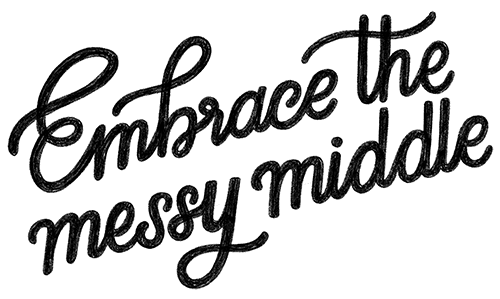The world is full of myths about art. Some good, some bad. These myths float around, getting passed from person to person and perpetuating the way that art is perceived and talked about. Many of these ideas are not only inaccurate; they’re damaging to artists and the ways that creative life/artists/the art world is perceived. Some of them keep us stuck, helpless, wheels spinning. And some of them are so culturally ingrained that we don’t even realise their myth-ness for what it is.
In order to move past these art myths, we need to be aware of them – so let’s take a closer look before we kick ’em to the curb.
An overview
- Picasso is the guy we should be looking up to
- The starving, crazy or otherwise-suffering artist
- Real artists go to art school
- My kid could have done that
- You need to move to Paris, New York or [insert similarly artistic city here] in order to make it as an artist
- Those who can’t, teach
- Artists are loners
1. Picasso is the guy we should be looking up to
Most people who don’t know a lot about art use Picasso as the pin-up boy of the art world. Many people who do know a lot about art do the same. Admittedly, Picasso made a lot of art. He was a talented draughtsman, an excellent painter and a good businessman. He had that relentless, crazy “edge” that makes him a popular contender for the Art World Darling of the Twentieth Century.
But the truth is, Picasso was a bit of a dick. Prolific, yes – and brilliant, maybe – but a misogynistic asshole nonetheless. Want some more facts to back me up? Watch Nanette by Hannah Gadsby, listen to Episode 20 of Sorry He Sucks, or read Life with Picasso by Francois Gilot (one of the many ladies in Picasso’s life).
2. The starving, crazy or otherwise-suffering artist
The starving artist myth has been around for a very long time indeed, becoming highly romanticised. Images are called to mind of the malnourished and slightly-crazed man in his drab, dimly lit studio. He’s painting fervently, struggling to make ends meet, hasn’t got two bread crusts to rub together, and is naturally decked out with raggedy clothed and a three-day-beard. Ok, we get it: it can be tough to make a living from art and art alone.
Why is this image always a man, and why does society seem to love the idea of people suffering for their art?
The issues with the myth of the starving artist are twofold: while it keeps so many from pursuing the creative life, it also encourages creatives to believe that they’re not real artists if they’re not starving or suffering in another appropriate manner. In Big Magic, Elizabeth Gilbert (the author of international bestseller Eat Pray Love) champions the mind-boggling idea that we should actually enjoy our creativity. She recounts being told by one of her high school English teachers, “You’re a talented writer, Liz. But unfortunately, you’ll never make it because you haven’t suffered enough in your life.” Ummm, whhaaaaa? She goes on to say,
“What does a middle-aged man know about a teenage girl’s suffering? I’d probably suffered more that day at LUNCH than he had in his entire lifetime. But beyond that – since when did creativity become a suffering contest?”
Suffering and malnourishment are not prerequisites for a creative life. And the truth is, plenty of artists are making a decent living and eating very well, thank you very much. If you want to be an artist, you can too.
3. Real artists go to art school
You do not need to go to art school to be a real artist, to be a successful artist, or to make good art. Going to art school will guarantee none of these things in exactly the same way that not going to art school will.
Having been to art school, I can safely say that I learnt some stuff there. I learnt some art making techniques, spent lots of time thinking about and making art, and I picked up lots of information about the art world along the way. It also took a huge swing at my creative confidence (thankfully, I’ve recovered). All art schools are different and each person’s experience of art school will be different. Basically, art school will suit some and not others – financially, emotionally, educationally, developmentally.
4. My kid could have done that
This frequently-heard statement has plagued the art world for decades.
Of course, the intent is often to declare an artwork which appears too minimal, messy or unrefined as unworthy. But there is a lot going on in the statement “my kid could have done that.” What is really being said is,
“this art is basic. It doesn’t match up to my idea of what ‘good’ art should be. The skills of this artist can be equated with those of my child – who isn’t yet very dextrous and also doesn’t have much idea about what ‘good’ art should be.”
If we really want to get down to the hard facts, your kid probably could have made something visually similar to that. First, they didn’t. Second, behind the statement is the presumption that art is all about appearance of the finished product, whereas process and ideas (concept) are vital factors in the creation and reading of a work of art.
And finally…kids make incredible art, and many artist spend their lives trying to regain the child-like spontaneity and freshness of their youths. So let’s not degrade fully grown artists or children making art by perpetuating this super-irritating art myth.
5. You need to move to Paris, New York or [insert similarly artistic city here] in order to make it as an artist
There are certain cities which are considered artistic meccas, with the best galleries, the most history, and the best artists. Once upon a time these were the places for artists to go to “make it”.
The truth is, you can make and sell your art from anywhere, and the arts are thriving in many regional areas. You won’t make your best art when you’re in “the best art city”, but rather when you’re in the place which makes you feel the most alive…or perhaps the most stressed, if you’re a fan of the suffering artist vibes. Whatever the best conditions are for your personal art making journey.
6. Those who can’t, teach
This is an old and terrible adage, with the idea being that those who can’t “really make it” in their chosen vocation often decide to teach instead. So, failed scientists become science teachers, failed historians become history teachers, and – you guessed it – failed artists become art teachers.
Teaching has always been a job which pairs brilliantly with art making. It provides a (sometimes) steady income to accompany the often unpredictable fiscal condition of living as an artist. Many brilliant, celebrated and award-winning artists teach, becoming mentors and inspiration to students and emerging artists.
7. Artists are loners
This one’s similar to the suffering artist myth. Indeed, the creative life can be a lonely one; part of this comes from needing to work in isolation, taking a path less-travelled and feeling misunderstood by those around them. Having said this, it need not be lonely. (PS: In a previous blog post I’ve written about ways to feel less alone as a creative.)
Like all people, artists can be introverted or extroverted – and go to any gallery opening and you’ll see that artists love a good party. In my experience, artists are incredibly open, generous and in tune with themselves – all qualities which fuel connection. I for one am super social by nature (although I also enjoy time to myself), and many of my closest friendships are with artists and other creatives.
What’s more, there are fantastic artist networks, societies, communities and support groups, both formal and informal, which connect artists. The Get Messy community is a great example of artists supporting each other, regularly meeting, collaborating, sharing their knowledge with each other and lifting each other up.



